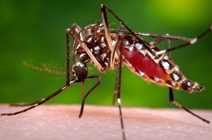CDC Test for Dengue Fever Approved

Dengue viruses are mainly transmitted by the bite of infected Aedes aegypti mosquitoes; an invasive, domestic species with tropical and subtropical worldwide distribution.
Dengue, a painful and sometimes deadly viral disease transmitted by mosquitoes, threatens more than 3.5 billion people worldwide. Dengue is endemic in at least 100 countries in Southeast Asia, the Pacific Islands, the Caribbean, Central America, South America, and parts of Africa.
As many as 100 million people become infected yearly, and nearly 500,000, mostly children, develop the potentially deadly dengue hemorrhagic fever.
Although dengue is not a new problem, it has emerged as an increasingly critical threat to public health worldwide, resulting in large and serious epidemics. The mosquito vectors of the virus have adapted to living in urban areas, and these changes in demographics favor transmission.
As the world has become more accessible and travel becomes more frequent, the risk from dengue viruses has increased. Large numbers of travelers return from dengue-endemic areas to the United States each year, increasing the possibility of introducing the virus to those parts of the United States where the mosquitoes capable of transmitting dengue still thrive.
Recently the Centers for Disease Control and Prevention developed a new diagnostic test to detect the presence of dengue virus in people with symptoms of dengue fever or dengue hemorrhagic fever.
The new test will help diagnose dengue within the first seven days after symptoms appear, which is when most people are likely to see a health care professional and the dengue virus is likely to be present in their blood. The test can identify all four dengue virus types. This is the first Food and Drug Administration (FDA)-approved molecular test for dengue that detects evidence of the virus itself. The other available test detects a certain type of antibody.
The need for the new dengue diagnostic test was high," said Jorge L. Munoz-Jordan, Ph.D., chief of the Molecular Diagnostics and Research at the Division of Vector-Borne Diseases' Dengue Branch. "Patients will be diagnosed sooner than before, and public health laboratories will have a clearer picture of the true number of dengue cases."
One of the most important features of the new test is that it can be performed using equipment and supplies that many public health laboratories already use to diagnose influenza. This makes it possible to begin using the test in the many laboratories in the United States and internationally that already run a frequently used flu test also developed by CDC.
Symptoms of dengue include high fever, severe headache, severe pain behind the eyes, joint pain, muscle and bone pain, rash and mild bleeding involving the nose or gums, and easy bruising. Severe infections can result in hemorrhage, shock, and death.
Although there is no vaccine to prevent dengue, timely medical care can greatly reduce the possibility of death.
People who believe they have dengue should immediately contact a health care professional. Early identification may be very helpful in determining the best course of treatment.
Kits will be available for distribution the week of 4th of July, 2012. More information about the new laboratory test can be obtained at the CDC dengue website at https://www.cdc.gov/Dengue/.
- Page last reviewed: March 19, 2014
- Page last updated: March 19, 2014
- Content source:


 ShareCompartir
ShareCompartir